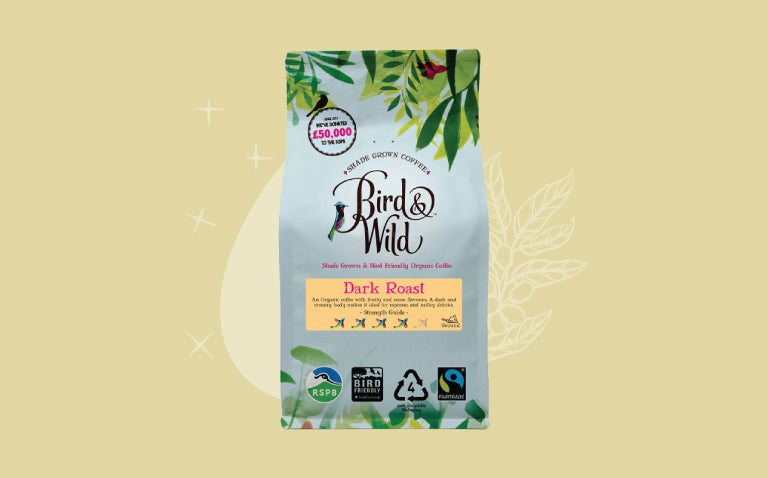
Coffee & Deforestation – we need to talk about coffee...
Coffee consumption has enjoyed a stratospheric rise in demand over the past couple of decades from both traditional coffee-drinking countries and the new coffee drinkers of the world.
So, demand rises and the market delivers the supply.
But where does this additional coffee supply come from?
Farmers have several choices:
i) Further intensify their coffee production with higher yield coffee varieties, use sun grown coffee methods and increase use of fertilisers and pesticides. This has its own problems – see our page on Sun Grown Coffee methods and why there are unsustainable/bad for so many reasons and actually bad for business in the long run.
ii) If they are growing other crops, replace these crops with coffee.
iii) Use new land – often virgin land – for coffee growing.
In many case, it’s easier and faster to clear the land and sow new coffee plants. It’s estimated that 13 million hectares of tropical forest is cleared every year globally. That’s the size of Greece every year.
And that means clearing tropical forests and jungle – and it’s happening at an ever growing pace. The EU is one of the largest drivers of tropical deforestation through our insatiable demand for agricultural commodities like coffee, cocoa and palm oil.
So, what is the EU saying about it?
Indeed, the European Union has woken up to this reality and has recently produced a long awaited Study called the EU Action Plan on Deforestation.
The leaders of the Study note that “Deforestation is the permanent destruction of forests and woodlands. While the phenomenon is not new, the current scale and pace of destruction is alarming. Tropical forests are disappearing at a rate of about 13 million hectares per year (approximately the size of Greece). This magnitude of destruction has an impact not only at a local level, but also globally. Tropical forests are home to much of the planet's biodiversity, hosting about half of all known species.”
“Cutting down forests not only threatens the extinction of a diverse range of plants and animals, but also causes climate disruption: deforestation is responsible for around 20% of global CO2 emissions, making it a major contributor to climate change. Together with forest degradation, it also poses a threat to the cultural integrity and way of life of people dependent on forests for their livelihood. The process continues as alternative land uses usually bring increased economic revenues in the short term, and this is why the deforestation rate remains so high in many countries.”
“Forests cover roughly 30% of the world's land area. Three percent of the earth's forest cover was lost between 1990 and 2015 and there has been no significant decrease in the rate of deforestation over the past 20 years. Some 96% of deforestation occurs in tropical regions.”
“Meeting the EU's objective of limiting climate change to 2°C above pre-industrial levels will require a cut of global emissions by at least 50% below 1990 levels by 2050. Such a reduction is impossible without substantial action to combat deforestation.”
Is the EU actually doing anything about it?
Although, of course, being the European Union, there are a lot of words and diplomacy, but it is not clear if and when the EU will work to counter deforestation caused by EU consumption.
The EU simply notes “the European Commission has presented a Communication on deforestation which sets out the EU's response to the challenge of climate change and, at the UNFCCC (United Nations Framework Convention on Climate Change) negotiations on the future climate regime, it has called for halting global forest cover loss by 2030 at the latest and reducing gross tropical deforestation by at least 50% by 2020 from current levels.
The Commission proposed to work in the international negotiations on climate change towards the development of a Global Forest Carbon Mechanism, a financial mechanism through which developing countries would be rewarded for emissions reductions achieved by taking action to reduce deforestation and forest degradation.
Simultaneously, the Communication identifies possible ways for the EU to contribute to such a mechanism. It also addresses policies that need to be reinforced in the fields of trade, energy, agriculture, food security and development cooperation in order to ensure a coherent policy response to address deforestation and forest degradation. The Communication also indicates that at EU level an appropriate level of funding is required from 2013 to 2020 to fight deforestation.”
So, the EU notes the urgency and scale of the problem of deforestation, but we won’t hold our breath when any clear measurable actions are taken.
What can you do about coffee and deforestation?
As a consumer, sometimes one feels powerless about the state of the world, but you can do something to help do your bit:
- Drink Smithsonian Insitute Certified Shade Grown Coffee
- Drink Smithsonian Insitute Certified Bird Friendly Coffee
Bird & Wild Coffee only roast coffee that is shade grown and forest grown in forest conditions, which grows organic coffee in sustainable conditions to last generations by respecting the soil and ecosystem.
A canopy of assorted types of shade trees is created to cultivate shade-grown coffee, which incorporates principles of natural ecology to promote natural ecological relationships.
Indeed, recent research points to a direct correlation between the structural complexity of a coffee plantation and the number of species found. In short, Shade Grown Coffee increases biodiversity. It’s a no-brainer really and similar to what we see with other monocultures that destroy biodiversity.
The forest-like structure of shaded coffee farms provides habitat for a great number of migratory and resident birds, reptiles, ants, butterflies, bats, plants and other organisms. Actually, off all agricultural land uses, shade-grown coffee supports the highest diversity of migratory birds, native flora and fauna.
Here are some bite size facts about Shade Grown Coffee:
- Shade Grown helps plant diversity with typically 90 to 120 species of plant and 13 to 58 species of tree on a single site. Herb diversity is typically 3 to 4 times higher as well.
- Shade Grown helps insect diversity with 609 species of insect found in a Shade Grown Coffee site in Mexico.
- Shade Grown helps both native and migratory bird species diversity. For example, 184 bird species (including 46 migratory bird species) were found on a single Shade Grown Coffee site in Mexico. This compares with as few as 6-12 bird species found in unshaded coffee monocultures.
- In a study of shade vs. sun coffee comparisons in Guatemala, overall bird abundance and diversity were 30% greater, respectively, in shaded farms than sun farms. Indeed, shade-grown trees housed two-thirds of the bird species found in natural forests in the same geographic area.
- Shade Grown Coffee promotes mammal diversity. For example, a Shade Grown Coffee site in India found 28 species of mammals in one site alone.
- Many species of bees are attracted to shaded polycultures that have a variety of flowering plants in addition to coffee. In a shade grown study in Indonesia, bee populations rose by 90%.
- Shade Grown protects soil. The presence of canopy and midstory vegetation in shaded polycultures helps reduce soil erosion as well stabilize steep, mountainous slopes. Typically, soil moisture is 42% lower in unshaded plantations than in shaded plantations and there is significantly less runoff of surface water in shaded plantations than in unshaded plantations.
- Shade Grown acts as a carbon sink. Just like natural forests, the carbon sequestered in a shade‐grown coffee farm’s shade trees will be stored in the tree trunks, limbs, leaves, and roots of the foliage as opposed to being in the atmosphere and adding to global warming.
So what else can you do?
Share this – tell your friends! Spread the word about coffee and deforestation.
Buy Shade Grown Coffee at Bird & Wild Coffee at www.birdandwild.co.uk in the United Kingdom or Birds & Bees Coffee at www.birdsandbeanscoffee.com in the United States.
There is still far too few Shade Grown Coffee plantations and we need to shout out about and grow this movement towards greater biodiversity on our coffee plantations.
Thank you. We can make a difference.





Leave a comment
This site is protected by hCaptcha and the hCaptcha Privacy Policy and Terms of Service apply.